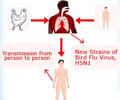Bacteria responsible for a devastating bird disease that spread from poultry to house finches in the mid-1990s evolves at an exceptionally fast rate, a new study has revealed.

When thousands of wild house finches started dropping dead from a mysterious eye infection in the Washington, DC, area in the winter of 1994, scientists were puzzled.
The birds had red, swollen, crusty eyes that left them unable to see or forage for food, until they eventually died from starvation or predation. Researchers soon identified the cause — a bacterium called Mycoplasma gallisepticum, a common cause of respiratory infections in turkeys and chickens that was previously known to infect only poultry.
By the time biologist Geoff Hill spotted his first sick bird in Auburn, Alabama, in 1995, the disease had spread through the eastern part of the continent, as far north as Quebec and as far south as Florida. "This was a devastating pandemic," Hill said.
Since its discovery, the epidemic has spread as far west as California, and is estimated to have wiped out hundreds of millions of birds. But scientists are still far from understanding how Mycoplasma gallisepticum gained the ability to spread to house finches — which diverged from chickens and turkeys some 80-90 million years ago — or what turned it into such a sweeping killer.
Advertisement











